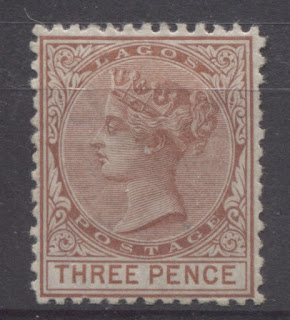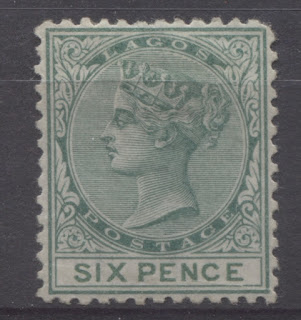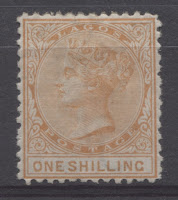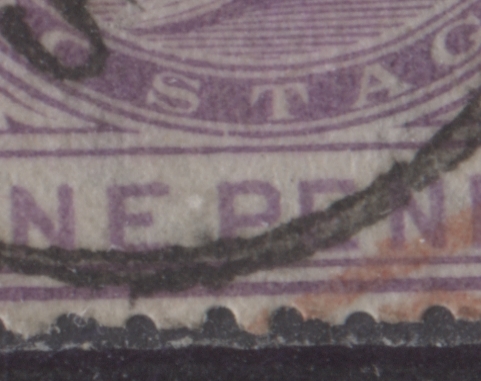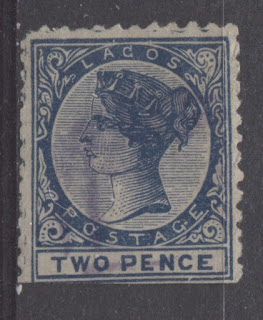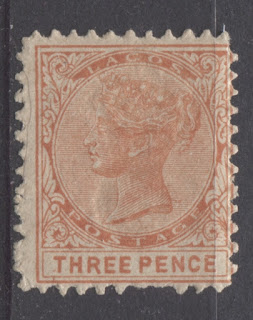Today's post will deal with the very first issue of Nigerian postage stamps: the Queen Victoria surface printed issue produced by De La Rue and first released in 1874. It will surprise many collectors to learn that there were no fewer than seven printings of these stamps issued between May 12, 1874 and May 13, 1875. With careful study and attention to colours, paper differences and cancellations, it is possible, I believe to distinguish them all. Despite this relatively high number of printings, the print quantities themselves were very small, with the result, that overall, these are by all accounts, very scarce stamps, especially mint with full original gum. Gibbons prices mint stamps with gum in fine condition, but in my experience, most mint stamps I encounter either have no gum at all, are sweated gum, or re-gummed. When the stamps are found with original gum, it is often very heavily hinged, or have pencil markings. Given the circumstances of the overall scarcity of the stamps, I do not believe that these issues should deter you from buying such stamps. I have never seen any mint blocks or multiples of any kind on either this or the perf. 14 crown CC issues, which again, is another indication of their immense scarcity.
Perforations present another challenge on this issue in the sense that most of the time they are not cleanly cut, which tends to turn off collectors who are not accustomed to rough perforations. Occluded perforations are the norm on these, and it is often only the last printings that have what most collectors would recognize as clean cut perforations.
The Stamp Designs Printings and Quantities Issued

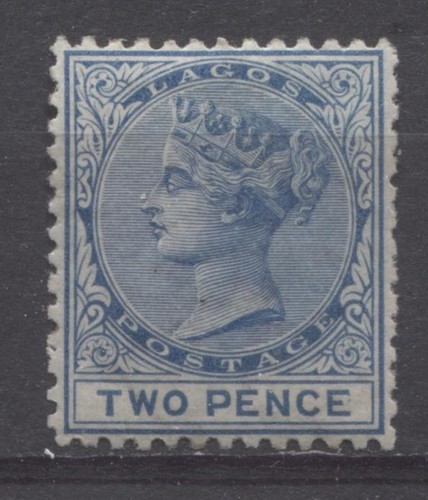











This is quite a dramatic frame break and occurs in the lower left corner of the design. I do not yet know if it is constant, as I have only seen it on this copy of the 2d.
String of Pearls Flaw
I have only seen this flaw on this printing of the 2d. So it may not be constant.
The "T" Flaw

Perforations present another challenge on this issue in the sense that most of the time they are not cleanly cut, which tends to turn off collectors who are not accustomed to rough perforations. Occluded perforations are the norm on these, and it is often only the last printings that have what most collectors would recognize as clean cut perforations.
The Stamp Designs Printings and Quantities Issued
1d Mauve
First printing - May 12, 1874 - 1,980 stamps.
Second printing - September 14, 1874 - 2,400 stamps
Third printing - November 18, 1874 - 3,060 stamps
Fourth printing - December 14, 1874 - 3,180 stamps
Fifth printing - February 3, 1875 - 3,000 stamps
Sixth printing - May 13, 1875 - 6,180 stamps
Overall total - 19,800 stamps
2d Blue
First printing - May 12, 1874 - 1,980 stamps
Second printing - September 14, 1874 - 2,520 stamps
Third printing - February 3, 1875 - 3,060 stamps
Fourth printing - May 13, 1875 - 6,540 stamps
Overall total - 14,160 stamps
3d Red brown
First printing - November 18, 1874 - 3,000 stamps
Second printing - December 14, 1874 - 3,300 stamps
Third printing - February 3, 1875 - 3,000 stamps
Fourth printing - May 13, 1875 - 6,480 stamps
Overall total - 15,780 stamps
4d Carmine
First printing - May 12, 1874 - 1,920 stamps
Second printing - August 13, 1874 - 2,160 stamps
Third printing - September 14, 1874 - 2,520 stamps
Fourth printing - November 18, 1874 - 3,180 stamps
Fifth printing - December 14, 1874 - 3,060 stamps
Sixth printing - February 3, 1875 - 3,180 stamps
Seventh printing - May 13, 1875 - 6,300 stamps
Overall total - 22,320 stamps
6d Green
First printing - May 12, 1874 - 2,040 stamps
Second printing - August 13, 1874 - 2,160 stamps
Third printing - September 14, 1874 - 2,520 stamps
Fourth printing - November 18, 1874 - 3,240 stamps
Fifth printing - December 14, 1874 - 3,240 stamps
Sixth printing - February 3, 1875 - 3,060 stamps
Seventh printing - May 13, 1875 - 6,360 stamps
Overall total - 22,620 stamps
1/- Orange (both types shown)
First printing - November 18, 1875 - 3,120 stamps
Second printing - December 14, 1874 - 3,120 stamps
Third printing - February 3, 1875 - 3,000 stamps
Fourth printing - May 13, 1875 - 6,360 stamps
Overall total - 15,600 stamps
In looking at the above quantities, at least three things become readily apparent:
1. These stamps are very scarce, with between 14,160 and 22,320 stamps printed of each value. To put this quantity in perspective, consider that most surface printed stamps of this period from GB were printed in the millions. Other colonies with large Caucasian populations such as Ceylon, Mauritius, Barbados, Bermuda and so forth had print quantities much larger than this for the lowest denominations. Now of course what really counts is not the quantity printed, but the quantity surviving. However, considering that these were issued before the Crown Agents retained stocks to sell to collectors and stamp dealers in the UK, we would expect that the survival rate of any stamps, would be much lower, given the impact that the tropical climate of Nigeria has on paper and gum.
2. All of the values are nearly equally scarce, with the 1d, 2d and 3d being every bit as scarce as the 1/-. Yet the Gibbons values for the 1/- are between five and eight times as much for the 1/- than the other values. In used condition, the 6d is a relatively inexpensive stamp, even though the quantity of 4d stamps printed was almost exactly the same. Therefore it is fair to conclude that the Gibbons and Scott catalogue prices for these stamps make absolutely no sense at all, given the quantities printed.
3. The last printings of each and every value are by far the most common, if the word common can even be used, with over 6,000 of each of the stamps coming from this printing. This means that there is a good chance that the stamp you have is from this printing. The other implication is that the catalogue values can reasonably be regarded as applying only to the stamps from this later printing. The very first printings of each value are exceedingly scarce, with fewer than 2,000 being printed, and it stands to reason that these should be far more valuable than the later printings. How much more valuable is not clear, but I would expect that 100% premium would not be unreasonable.
The low quantities make it very clear that any multiples, whether they be mint or used, will be actual rarities, and not merely scarce.
Intended Usages
The intended usages for the stamps of this issue were as follows:
- The 1d lilac was used primarily for local letters up to 1/2 ounce, as an add-on for each additional 1/2 ounce, and newspapers.
- The 2d blue was used primarily for local letters weighing more than 1/2 ounce, but less than 1 ounce.
- The 3d red brown was used for local letters between 1-11/2 ounces, or local parcels not exceeding 8 ounces.
- The 4d carmine was used either for local letters weighing 11/2-2 ounces or letters to other West African ports not exceeding 1/2 ounce.
- The 6d green was used either for local parcels weighing between 8-16 ounces or letters to the UK weighing less than 1/2 ounce.
- The 1/- orange would have been used primarily for 1 ounce letters to the UK, but could also have been used on heavier parcels.
Design, Engraver, Plates and Plate Layout
The design was a hybrid of the designs used for the South Australia 1d stamp and the first issue of St. Christopher. The engraver of the design is believed to have been De La Rue's chief engraver, M. Jean Ferdinand Joubert.
Two plates were used for printing:
- The key plate, which comprised the entire design except for the value, and
- The duty plate, which was the words of value.
The key plate used for all issues up to 1901 was plate 1, and the stamps were printed in sheets of 60 being laid out in 10 horizontal rows of 6 stamps. The sheet margins of the sheets bore no jubilee border lines, but the key plate #1 was printed in white on a ball of colour located both above stamp #2 and underneath stamp #59 in the sheet. In addition, the "current number" was printed in colour in a white oblong with voided corners, above stamp #5 and under stamp #56. I have only ever seen these on the later issues. In fact the earliest issue I have with these marginal markings like this is the first Crown CA issue of 1882. The current number is interesting. Many collectors misinterpret this as a plate number, when it is not. What it actually represents is the order in which plates were laid down since 1861, regardless of country. In 1874 each colony was allocated its own sequence of numbers, starting from number 1 in each case. Thus for these issues, we would expect the number to always be "1", though a different number would signify the existence of more than one plate. This system was eventually abandoned, but continued in use until the mid 1890's.
There were two different duty plates used for the 1/- value. The first one is shown in the scan on the left. In this type, the words "one shilling" are 15.5 mm long, and there is no crossbar to the "g". The second type is shown in the scan at right, and is the more common of the two. The letters are heavier, 16.5 mm long and there is a distinct crossbar to the "g".
Paper and Gum
The paper used for this issue was a medium white wove, watermarked crown CC. The gum was colourless, thin and matte. It is very distinct and quite unlike any gum seen on the crown CA issues, which is yellowish by comparison. Here is what the back of a typical mint stamp from this issue looks like:
This stamp is the second printing of the 2d and what stands out on this is the lack of clear mesh in the paper and the thickness of the gum. The first printings were made on paper that shows clear mesh and tended to have slightly thicker and shinier gum than the later printings which were on paper showing a no visible mesh. The gum used on the perf. 14 crown CC issues was thinner by comparison to the gum used on these issues. Here are some examples to show the difference between the papers used:
A used copy of the first printing 2d. Note the visible vertical mesh.
A used example of the fifth printing of the 1d. Note the complete lack of visible mesh.
Shades
Because the duty plate was printed separately from the key plate, there are often instances where the colour of the inscription differs from the colour of the rest of the stamp. This becomes critical to identifying the different printings. Below are two scans of two printings of the 2d blue, which show how different these colours can be:
The first printing - note how the colour of the words is the same as the rest of the stamp.

The 4th printing. It is a little hard to see on this scan, but if you look closely and allow you eyes to adjust, you will see that the colour of the words "two pence" is a greenish blue in comparison to the deep bright blue of the rest of the stamp. Here are two more scans, showing the differences on the 1d:
The first printing of the 1d reddish violet.
The third printing of the 1d reddish lilac and dull purple.
Cancellations and Manuscript Markings
Cancellations
The very first cancellations were Lagos CDS's that had only a time code and no year date.
The next cancels were almost identical, but had the year date.
The cancellation most often seen on the last printings of all values. This was an "L" inside a barred diamond grid. It was introduced in early 1876.
Many collectors dislike the last type, as it was often struck heavily and will insist on CDS cancels. However, this type is the normal cancellation used on the last printings of this issue, and as long as it is struck clearly, stamps should not be downgraded by collectors just because they are not cancelled with a CDS. The undated types are all rare and worth a considerable premium. Nearly all the used 1/- stamps that I encounter are cancelled with the barred diamond grid unless they are the first type. Type 2 examples with CDS cancels are scarce and worth a premium as well.
Manuscript Markings
Occasionally one will come across a stamp like the one shown above where a manuscript marking is visible in conjunction with the cancel. It could be easily dismissed as a fiscal marking or pen cancellation. However another explanation is more plausible. J.F Ince, in his work titled "The Postage Stamps and Postal Stationery of the Colony of Lagos 1874-1906" suggests that these were the initials of the original owners of the stamps. He goes on to discuss how in the Falkland Islands there was a system whereby a person or firm that was far away from a post office could send unfranked mail to the office that would then frank the mail with stamps that they held on account for the person or firm. In order to avoid mixing up one person's stamps with another, the stamps were marked with a manuscript letter or set of initials. He goes on to express doubts about the plausibility of this theory as it relates to this issue on the grounds that the only examples he saw were marked with the letter J. However the above example is not the letter J, and I have other examples with different letters. I am convinced that his theory is correct and that these represent ownership markings. In light of the overall scarcity of the basic stamps, these must be quite rare in reality.
Plate Flaws
I have noticed several plate flaws on this issue, some of which are definitely constant. I have determined this as a result of seeing the exact same flaws on later issues. Unfortunately not enough large multiples exist to establish the exact plate positions of these flaws. I will add additional scans of the other flaws as more become available, but for now, here are the flaws that I have encountered so far:
Frame Break Below Last "E" of "Pence"
Clear break in the frameline below "Pence". I have only found this on the 6d so far and not on the later issues.
Small Frame Break between the "S" and "T" of "Postage"
I have only found this on the 1d so far.
The truncated First "N" of "Penny"
You can see that the first "N" of "Penny" is clearly shorter than the second. I have found this on the 1d carmine crown CA stamps, which suggests that it was never corrected, and is constant.
Flaw in "Y" of Penny
A little white bubble appears in the stem of the "Y". I have found this on later issues, suggesting that it is indeed constant and was never corrected.
Broken Frame at Lower Left
This is quite a dramatic frame break and occurs in the lower left corner of the design. I do not yet know if it is constant, as I have only seen it on this copy of the 2d.
String of Pearls Flaw
What resembles a string of pearls appears above the letters of value. Again, I have only seen it on this copy of the 2d, so I do not know if it is constant.
The Dot After "O"
This may be a freak flaw, as I have only seen it on this copy of the 2d.
The Apostrophe Flaw
I have only seen this flaw on this printing of the 2d. So it may not be constant.
The "T" Flaw
This is definitely constant, and was never corrected, as I have seen this on every single printing of the 2d from this issue all the way up to the bicolour issue of 1887.
The cracked "TH"of "Three" Flaw

This constant flaw appears on the 3d red brown. I have two used examples that are exactly the same, so I know it is constant. However, I have not seen it on any 3d stamp after 1876, so it would appear that it has been corrected in later issues. It consists of a crack in the letters "TH" of "Three".
None of these plate flaws are listed in Gibbons, which is not all that surprising, given that practically none of the flaws that are now listed for other colonies, such as the "detached triangle", "damaged S" and the like were listed until very recently. They are a big deal because the printing standards for De La Rue were extremely high. Plate flaws of any kind seldom occurred and the immense rarity of those that do exist becomes very apparent when one considers that over 60 crown colonies each had several stamp issues printed by De La Rue. All in all, they printed millions upon millions of stamps between 1860 and the late 1950's with the number bearing any kind of flaw being minuscule.
Specimens and Proofs
All of the stamps are known overprinted "Cancelled". Two different types of font are known, but unfortunately I do not have an image of either to show here. In addition, they all exist overprinted "specimen" in two different fonts. Again, I do not have any examples that I can illustrate here, as they are all very rare.
An essay is known of the 1d with a printed head in mauve and a hand painted frame, also in mauve, and with the value in red. It is on a glazed card, dated "16 Jan 74" and marked "Approved M.S".
Eight different die proofs are known of this issue:
- On white glazed card, printed in black, marked "Before Hardening" and dated "Mar 25, 1874".
- On white glazed card printed in black with the value blank.
- On white glazed card printed in lilac with the value blank and overprinted "specimen".
- On white glazed card, printed in black, marked "Before Hardening", endorsed in pencil "Penny Halfpenny" and dated "Mar 25, 1874".
- On white glazed card, printed in black, marked "After Hardening", with the value "Penny Halfpenny added", and undated.
- On glazed card, printed in black, value blank, marked "Before Hardening", with "Threepence" in the lower right corner in watercolour. It is also annotated in pencil "This is too small, Mr. W.W.D says larger". The initials W.W.D likely stand for William Warren De La Rue, who was a partner in the firm at the time.
- On an irregular piece, maximum size 110 x 42 mm, bearing cut down die proofs of the design without value; 1d, 2d, 4d and 6d value tablets and then marked "April 2, 60 leads each".
- On an irregular piece 42 x 46 mm with similar die proofs of the 3d and 1/- each with manuscript "Lagos" and the entire piece marked "Oct. 31st 60 leads each plate" and endorsed in red ink dated 'Nov. 1874".
These pieces are all unique as far as I know. The "Penny Halfpenny" value was used for postal stationery, which consisted of letter cards and reply cards. Although the design was first prepared in 1874, the first postal stationery items would not be issued until 1879.
Two different plate proofs are known:
- The 1d as issued, but imperforate., and
- the 6d as issued, but imperforate.
Again, these are both very rare, if not unique.
Forgeries
There are several different types of forgeries that I have found of the stamps of this issue. Fortunately all of them are quite crude and can be easily spotted. Below are some examples of what I have encountered:
These last two have printed crown CC watermarks.
This concludes my overview of this issue.The next posts will deal with each value individually and will describe the characteristics of each printing, and provide tips for how to identify them.

